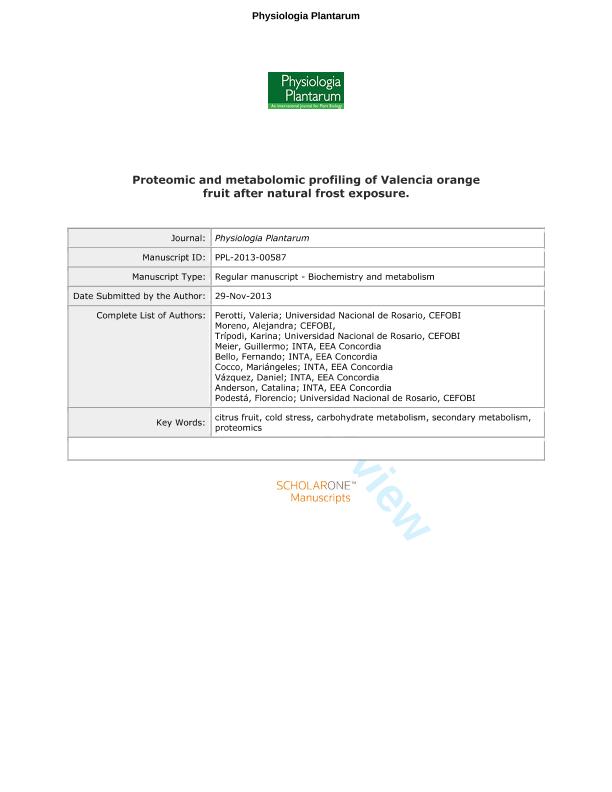Artículo
Proteomic and metabolomic profiling of Valencia orange fruit after natural frost exposure
Perotti, Valeria Elisa ; Moreno, Alejandra S.; Tripodi, Karina Eva Josefina
; Moreno, Alejandra S.; Tripodi, Karina Eva Josefina ; Meier, Guillermo; Bello, Fernando; Cocco, Mariángeles; Vázquez, Daniel; Anderson, Catalina; Podesta, Florencio Esteban
; Meier, Guillermo; Bello, Fernando; Cocco, Mariángeles; Vázquez, Daniel; Anderson, Catalina; Podesta, Florencio Esteban
 ; Moreno, Alejandra S.; Tripodi, Karina Eva Josefina
; Moreno, Alejandra S.; Tripodi, Karina Eva Josefina ; Meier, Guillermo; Bello, Fernando; Cocco, Mariángeles; Vázquez, Daniel; Anderson, Catalina; Podesta, Florencio Esteban
; Meier, Guillermo; Bello, Fernando; Cocco, Mariángeles; Vázquez, Daniel; Anderson, Catalina; Podesta, Florencio Esteban
Fecha de publicación:
05/2014
Editorial:
Wiley
Revista:
Physiologia Plantarum
ISSN:
0031-9317
Idioma:
Inglés
Tipo de recurso:
Artículo publicado
Clasificación temática:
Resumen
The aim of this study was to evaluate the response of orange fruit (Citrus sinensis var. Valencia Late) to freezing stress in planta, both immediately after the natural event and after a week, in order to understand the biochemical and molecular basis of the changes that later derive in internal and external damage symptoms. Using two-dimensional differential gel electrophoresis to analyze exposed and non-exposed fruit, 27 differential protein spots were detected in juice sacs and flavedo, among all comparisons made. Also, primary and secondary metabolites relative contents were analyzed in both tissues by gas chromatography-mass spectrometry and liquid chromatography-mass spectrometry, respectively. Proteins and compounds involved in regulatory functions, iron metabolism, oxidative damage and carbohydrate metabolism were the most affected. Interestingly, three glycolytic enzymes were induced by cold, and there was an increase in fermentation products (volatiles); all of that suggests that more energy generation might be required from glycolysis to counter the cold stress. Moreover, a notable increase in sugar levels was observed after frost, but it was not at the expense of organic acids utilization. Consequently, these results suggest a probable redistribution of photoassimilates in the frost-exposed plants, tending to restore the homeostasis altered by that severe type of stress. Isosinensetin was the most cold-sensitive secondary metabolite because it could not be detected at all after the frost, constituting a possible tool to early diagnose freezing damage.
Palabras clave:
Citrus
,
Proteomics
,
Glycolysis
,
Metabolomics
Archivos asociados
Licencia
Identificadores
Colecciones
Articulos(CEFOBI)
Articulos de CENTRO DE EST.FOTOSINTETICOS Y BIOQUIMICOS (I)
Articulos de CENTRO DE EST.FOTOSINTETICOS Y BIOQUIMICOS (I)
Citación
Perotti, Valeria Elisa; Moreno, Alejandra S.; Tripodi, Karina Eva Josefina; Meier, Guillermo; Bello, Fernando; et al.; Proteomic and metabolomic profiling of Valencia orange fruit after natural frost exposure; Wiley; Physiologia Plantarum; 153; 3; 5-2014; 337–354
Compartir
Altmétricas



